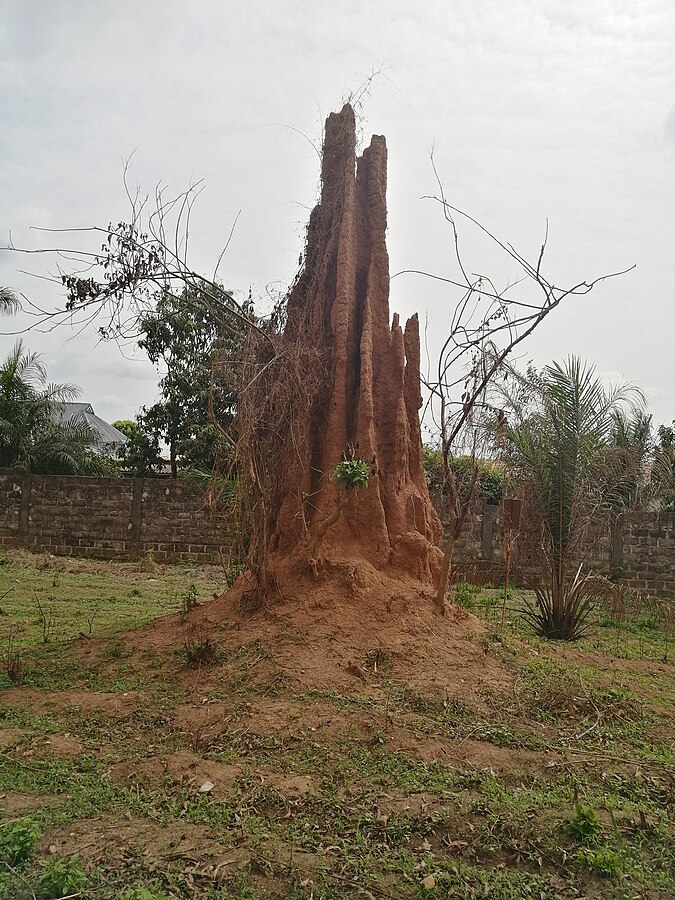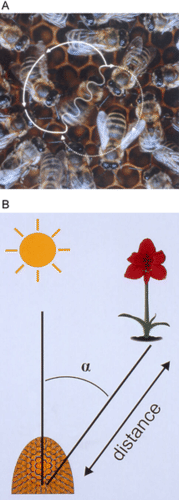15.40 昆虫行为 - 高级
章节大纲
-
Teamwork?
::团队合作?Yes, many , especially bees and ants, work as a team for all to survive. Each individual has a specific job and relies on other individuals for survival. Teamwork is a type of behavior.
::是的,许多人,特别是蜜蜂和蚂蚁,都作为一个团队工作,为所有人生存。每个人都有具体的工作,依靠其他人生存。团队工作是一种行为。Insect Behavior
::昆虫行为行为What exactly is behavior? It is defined as the way that organisms respond to their environment and to internal signals. In addition to many basic behaviors that are shared by other invertebrates , such as mating , there are some insect that are capable of more advanced forms of interaction with each other and with their environments. There are two types of behavior that can be observed in organisms: and . Innate behavior is genetically encoded. Flight and mating habits are considered innate behaviors. You have probably seen a clear example of innate insect behavior called the dorsal light reaction. Flying insects will sense the direction of light coming from the sun and fly in a way that keeps the sun overhead, or on their dorsal side. This is a means for the insect to maintain a flight plan that is parallel to the ground. You may have witnessed that this innate behavior is not so helpful when a moth encounters an artificial light source and flies in continuous circles around it to keep the light on its dorsal surface. At times, the moth is not able to fly away from that light source and, in essence, becomes trapped. Another insect behavior that you have probably experienced firsthand is sound production. Some insects produce sounds in order to communicate . An example is the chirping of crickets that often lulls us to sleep on warm summer nights.
::确切地说, 行为是什么? 它被定义为生物体如何应对环境以及内部信号。 它的定义是生物体如何应对其环境以及内部信号。 除了其他无脊椎动物所共有的许多基本行为外, 比如交配, 还有一些昆虫能够相互之间以及与它们的环境进行更先进的互动。 有两种类型的行为可以在生物体中观察到: 和。 自然行为是基因编码的。 飞行和交配习惯被认为是内在行为。 您可能已经看到一个叫做声光反应的遗传昆虫行为的明显例子。 飞虫将感知阳光从太阳发出的方向, 飞翔的方式是维持太阳的上方, 或飞翔的方式是它们的背面。 这是昆虫保持与地面平行的飞行计划的一种方法。 你可能已经看到, 当一只飞蛾遇到人工光源并在它的周围连续循环中飞动以保持其皮肤表面的光亮。 有时, 飞虫无法从这个光源中飞出, 和飞翔的方向, 使太阳在它的背上, 或者在它的背上, 被困住着。 这是昆虫保持一种与地面平行的飞行方式。 。 另一种昆虫行为通常会产生一种温度 。Learned behaviors are those that are not encoded genetically and are not present in the organism at birth. They are obtained through life experiences, and they can change or improve over time. Learned behaviors require acute sensing of environmental signals and a fairly complicated network of nerve connections for transmitting those signals in order to process the information and modify or initiate a behavior. Insects are capable of this level of behavior. In order to forage for food and return to the same food source repeatedly, they use a type of learning called associative learning. Associative learning is when separate ideas or environmental stimuli are connected to each other. For example, the location of a food source can be associated with a series of visual cues seen on the way to the source. In this way, the organism learns that if it follows a path that includes all of those visual cues, it will again find the food source. There are examples of this type of learning that can be tested experimentally. For example, honeybees can be taught to obtain their food from a particular source based on color cues, even when the location of that source changes. They can learn that their food (sugar water) is located on a yellow dish next to a blue dish containing only . If the dish positions are switched, the bees remember which color has the food, and they seek that dish.
::学习是那些没有编码的遗传行为, 并且没有出现在生物中。 它们通过生活经历获得, 并且可以随着时间的变化而改变或改善。 学习行为需要对环境信号的急性感知以及相当复杂的神经连接网络来传递这些信号, 以便处理信息, 修改或启动某种行为。 昆虫能够达到这一水平的行为。 为了提取食物, 并反复回到同一食物来源, 它们使用一种叫作关联学习的学习类型。 联合学习是当不同的思想或环境刺激相互连接时。 例如, 食物来源的位置可以与一系列在通往源的路上看到的视觉提示联系起来。 这样, 有机体学会如果遵循一条包含所有这些视觉提示的路径, 它会再次找到食物来源。 举例来说, 这种类型的学习可以被实验。 例如, 蜜蜂可以被教导如何从某个特殊的源获得食物, 即使是在下一个源的位置变化时, 也可以知道食物的来源可以与一系列视觉提示联系起来。 他们可以学习到一个颜色的位置, 如果他们的饮食是黄色的, , 它们只能记住一个颜色的餐盘, 。There are several groups of insects that have evolved complex social networks that involve elaborate patterns of between individuals within the community. These species are called social insects, and we will examine their behavior in the next section.
::有几组昆虫进化了复杂的社会网络,其中涉及社区内个人之间复杂的模式。这些物种被称为社会昆虫,我们将在下一节中研究它们的行为。Social Insects and Communication
::社会昆虫和交流Insects and other organisms that live together in well-organized and tightly integrated colonies are called eusocial . Eusocial insects include species of ants, termites, bees, and wasps. Some colonies can include millions of individual animals. These are two of the major features of eusocial insects:
::昆虫和其他有机体在组织良好和紧密结合的聚居区共同生活,它们被称为“社会生态 ” 。 生态社会昆虫包括蚂蚁、白蚁、蜜蜂和黄蜂等物种。 有些聚居区可以包括数百万只动物。 它们是“社会生态昆虫”的两个主要特征:-
Division of reproductive
labor
.
::生殖分工。 -
Cooperative care of the young members of the colony.
::殖民地青年成员的合作照顾。
Social ants are a good example of the division of reproductive labor. The individual ants within a colony divide up into three major groups:
::社会蚂蚁是生育劳动分工的好例子。 殖民地内的个人蚂蚁分为三大类:-
Fertile females (queens).
::女性肥料(排)。 -
Infertile (sterile) females (workers).
::不育(不育)女性(工人)。 -
Fertile males (drones).
::铁质雄性(drunes)。
Fertile males and queens carry out the reproductive activities of the colony, while workers focus on obtaining food as well as building and maintaining the nest or hive. In some social insect colonies there are other specialized individuals; nurses, for example, feed and care for young larvae . Often times, some individuals in a colony will form a defensive army with the main purpose of defending the nest.
::肥壮的雄性和女皇后从事殖民地的生殖活动,而工人则专注于获取食物以及建造和维持巢穴或蜂窝,在有些社会昆虫殖民地中,还有其他专门人员;护士,例如幼虫的喂养和照料;有时,殖民地中的一些人将组成一支防御部队,其主要目的是保卫巢穴。A Termite Nest. This cathedral-like structure is the nest of a huge colony of termites in Australia. In fact, it is the world’s largest known termite nest. It towers 7.5 meters (25 feet) above the ground and houses millions of termites. Communication between members of a colony can take several different forms. Ants generally communicate using pheromones . Pheromones are that are released by one individual to be sensed and responded to by another individual. You may have noticed how a group of ants making their way to a crumb on the ground will generally travel lined up one in front of the other. This is because they are sensing and following a trail of pheromones that was laid down by an earlier ant that discovered the crumb. On its way back to the nest, this little pioneer (called a forager) left a trail of pheromone for other colony members to follow.
::殖民地成员之间的交流可以有几种不同的形式。 蚂蚁通常使用pheomones进行交流。 Pheromones是由一个人释放的, 由另一个人加以感知和回应。 你可能注意到一群蚂蚁在地面向碎屑移动时, 通常会排在另一群人前面。 这是因为它们具有感知性, 并跟随早期发现碎屑的蚂蚁所绘制的一小串pheomones。 在返回巢穴的路上, 这个小先锋( 称为 a forager ) 留下一串球球素, 供其他殖民地成员跟随。Honeybees have evolved a fascinating form of communication using body movement . These insects perform an elaborate dance called the “waggle dance” to tell other colony members where to find a source of food. The angle of the dance indicates the particular direction of the food source relative to the sun, and the length of the dance correlates with how far away the food is, as shown in Figure . This is considered a form of abstract symbol communication, meaning that they use a behavior to represent information (in this case a location) about something in the environment.
::蜜蜂利用身体运动发展了一种令人着迷的交流形式。这些昆虫表演了一场叫“跳舞”的精细舞蹈,告诉其他殖民地成员哪里能找到食物来源。 舞蹈角度显示了食物来源相对于太阳的特定方向,舞蹈长度与食物的距离相关,如图所示。这被视为一种抽象的符号交流形式,意味着它们使用一种行为来代表环境信息(这里指的是一个地点 ) 。Bee communication. Some bees can tell each other the location of a food source by performing a “waggle dance.” The dance is outlined in this diagram. The angle (alpha) of the “waggle,” represented by the wavy section of the bee’s path, from the sun indicates the direction of the food source. The length of the “waggle dance” indicates how far away the food source is. In addition to the ability to learn, some species of social insects have also been shown to teach behaviors to other individuals. An example of this is seen in one ant species where the forager ant (the one who ventures out to find food) will actually take the time to lead a nest-mate to a new food source, in a way teaching the nest-mate how to forage.
::除了学习能力之外,一些社会昆虫还被证明向其他人传授了行为。 一个例子是,在一个蚂蚁物种中,觅食蚂蚁(冒险寻找食物的蚂蚁)实际上需要时间才能带领巢巢巢动物找到新的食物来源,从而教导巢巢巢动物如何觅食。Altruism is another feature of many social insects. Altruism is the act of self-sacrifice for the benefit of others. A worker bee, for example, forfeits her own potential for in order to obtain food and provide shelter for the benefit of the queen bee. This allows the queen bee to focus on the reproduction of her genetic material at the cost of the worker bee reproducing her own genetic material. This complex phenomenon is a favorite topic of study among philosophers and sociologists, and there are a number of different theories on the evolutionary advantage of altruism that you can read about in the : Evolution (Advanced) concept. What do you think might be the evolutionary driving force behind altruism?
::利他主义是许多社会昆虫的另一个特征。利他主义是为他人的利益而自我牺牲的行为。例如,一个工人蜜蜂丧失了自己获得食物和为女王蜜蜂的利益提供栖身之所的潜力。这使女王蜜蜂能够以工人蜜蜂复制自己的遗传材料为代价,专注于遗传材料的复制。这个复杂的现象是哲学家和社会学家们最喜爱的研究课题,在利他主义的进化优势方面,有一些不同的理论,你们可以从“进化(Advanced)”概念中读到。你认为什么可能是利他主义背后的进化驱动力?KQED: Ants: The Invisible Majority
::KQED: 蚂蚁: 隐形多数Most of us think ants are just pests. But not Brian Fisher. Known as “The Ant Guy,” he's on a mission to show the world just how important and amazing these little creatures are. In the process, he hopes to catalog all of the world's 30,000 ant species before they become casualties of habitat loss .
::我们大多数人认为蚂蚁只是害虫。但Brian Fisher不是。他被称为“蚂蚁 ” ( The Ant Guy ) , 他的使命是向世界展示这些小生物的重要性和惊人性。在这个过程中,他希望在它们成为生境损失的伤亡之前,把世界上的3万只蚂蚁全部编成目录。KQED: Ladybugs: A Population of Millions
::KQED: 虫: 百万人口Ladybugs, also known as ladybird beetles, have a of four to six weeks. In one year, as many as six generations of ladybird beetles may hatch. In the spring, each adult female lays up to 300 eggs in small clusters on plants where aphids are present. After a week the wingless larvae hatch. Both the ladybird beetle larvae and adults are active predators , eating only aphids, scales, mites, and other plant-eating insects. The ladybugs live on the vegetation where their prey is found, which includes roses, oleander, milkweed, and broccoli. Adult ladybugs don’t taste very good. A careless enough to try to eat one will not swallow it.
::虫(又称虫甲虫)有4至6周的时间。一年中,多达6代的虫可能孵化。在春天,每个成年雌性将在有虫的植物上小堆放多达300个鸡蛋。一周后,无翅膀的幼虫孵化。母虫幼虫和成年幼虫都是活跃的捕食者,只吃虫子、天花板、老鼠和其他植物食用昆虫。女虫生活在猎物所在的植物上,包括玫瑰、牛油、牛奶和花椰菜。成年母虫吃不饱,吃不饱。By late May to early June, when the larvae have depleted their food supply, the adults migrate to the mountains. There, they eat mainly pollen . The ladybugs gain fat from eating the pollen, and this tides them over during their nine-month hibernation . Thousands of adults hibernate overwinter in tight clusters, called aggregates , under fallen leaves and ground litter near streams. In the clear, warmer days of early spring, the ladybugs break up the aggregates and begin several days of mating.
::到5月底到6月初,当幼虫耗尽食物供应时,成年人迁移到山上,在那里,他们主要吃花粉。在5月底到6月初,当幼虫耗尽食物供应时,他们主要吃花粉。在5月底到6月初的时候,它们吃花粉后,小虫因吃花粉而变胖,这使他们在9个月的冬眠期间潮涨。数千个成年人在紧凑的团团里冬眠,称为集料,在落叶下,在溪边的地上乱翻。在春初的明日,小虫把集成碎裂开来,开始交配数天。Summary
::摘要-
There are two types of behavior that can be observed in organisms: innate and learned.
::在生物体中可以观察到两种行为:先天行为和先天行为。 -
Insects are capable of learned behavior.
::昆虫有能力学习行为。 -
Two of the major features of eusocial insects are division of reproductive labor and cooperative care of the young members of the colony.
::社会性昆虫的两个主要特征是,对殖民地的年轻成员进行生殖劳动分工和合作护理。 -
Communication between members of a colony can take several different forms such as "dances" or pheromones.
::殖民地成员之间的交流可采取几种不同的形式,如“舞动”或“花粉”。 -
In addition to the ability to learn, some species of social insects have also been shown to teach each other various behaviors.
::除了学习能力外,还显示一些社会昆虫的种类相互传授各种行为。
Review
::回顾-
In every day life, we often see insects circling a light source at night. What is this behavior called, and why has it evolved in insects?
::每天的生活中,我们经常看到昆虫在夜里在光源中盘旋。这叫什么行为,为什么它演变成昆虫呢? -
Bees, ants, and termites are all considered eusocial animals. What characteristics distinguish eusocial insects?
::蜜蜂、蚂蚁和白蚁都被视为社会性动物。 哪种特征区别于社会性昆虫? -
How do species such as ants and bees communicate with each other within their complex social structure?
::蚂蚁和蜜蜂等物种在其复杂的社会结构内如何相互沟通?
-
Division of reproductive
labor
.


